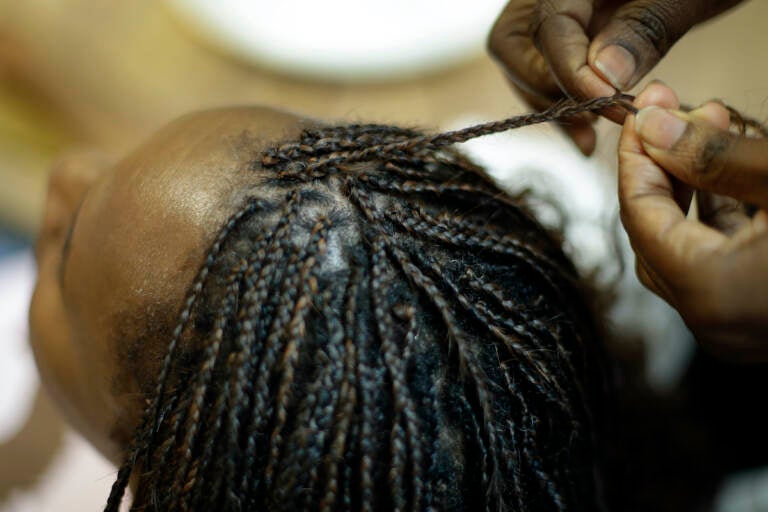From Philly and the Pa. suburbs to South Jersey and Delaware, what would you like WHYY News to cover? Let us know! Braids are more than just a hairstyle, they’re a long-standing tradition in Black communities, passed down through generations and worn for a number of reasons, from convenience to self-expression. There are hundreds of hair-braiding salons in Philadelphia alone.
But new research is raising questions about how safe these styles really are. A recent Consumer Reports investigation found that samples from 10 popular synthetic braiding hair products contained known carcinogens. Lead showed up in nine of the products, and all samples had other harmful chemicals, including volatile organic compounds.

Christine Martey-Ochola, a Philadelphia scientist and co-founder of organic and natural hair care brand Nuele, wasn’t surprised at these findings. “It’s not peculiar to me that we have products that are made with synthetic fibers that are plastic polymers, made with ingredients and solvents that could be problematic,” she said after reviewing the report. “This is knowledge that’s been available to the public, but not in the manner that it was composed in the Consumer Report.
” Martey-Ochola has long advocated for more transparency when it comes to potentially harmful ingredients in hair care ingredients — a concern that helped inspire the creation of her products. “The hair sector is one that has often gone unregulated and unnoticed, especially around ingredients that might not necessarily be the best for our health,” she said. “So I started to research hair products and hair ingredients.
” Growing up, she experienced scalp irritation from braids and assumed it was from tight styling. “I always thought that I just didn’t like braids because they made me feel miserable. Not realizing that they made me feel miserable because they had these toxic ingredients in them that caused my scalp to get very inflamed,” she said.
Philly woman uses her experience with vestibular disorders to increase awareness and support for others Vestibular disorders is a group of conditions that can include symptoms like dizziness, imbalance, vertigo and hearing loss. 2 weeks ago While tightness can contribute to scalp inflammation, Martey-Ochola says long-term chemical exposure could pose serious health risks. Toxins can be ingested through hand-to-mouth contact, or even inhaled during styling.
Most synthetic braiding hair is made from plastic fibers and treated with chemical coatings. At the end of a braiding session, it’s common for stylists to dip the braids in hot water, to seal the ends and keep them from unraveling. But heating the synthetic hair can release volatile organic compounds into the air.
These compounds can irritate the eyes, nose and throat, and in some cases, have been linked to cancer and damage to the nervous system. “So if we think about the person who braids, they’re continuously being exposed to volatile organic compounds and also on their hands. It would be interesting to see what the long-term public health impacts are on individuals who are braiders,” Martey-Ochola said.
She encourages consumers and stylists to become more aware of the ingredients in their hair products and to consider the possible long-term effects. “We’ve been conditioned for a long time to just use products that give us a look that we wanted,” she said. “But we didn’t always look at ingredient labels and see what the long-term health impacts were of some of these ingredients.
” Does pretty hurt? A look at the health risks of hair dyes Coloring is a complex chemical reaction, a sophisticated organic synthesis, that takes place in each strand on the top of your head. 6 years ago With limited regulation in the hair care industry, Martey-Ochola calls for more transparency around product ingredients. “I think people should be given that choice on what they’re going to expose themselves to.
We can’t force people to make some decisions, of course, but I think it’s helpful to have that knowledge,” she said. Braids remain a go-to hairstyle because they’re stylish and easy to manage. But Martey-Ochola says that doesn’t need to come at the cost of long-term health.
“Braiding is a natural age-old event that has happened in the black community for centuries. And a long time ago, we used cotton thread, right? And so those were safer options,” she said. “So I’m not saying let’s not braid, but let’s just think about what are some of those safer options that can be put in the market.
” For her, the conversation goes far beyond beauty. It’s about health. “When I see a little girl in braids, I don’t just see beauty — I see the possibility of long-term health consequences, and that’s painful,” she said.
Get daily updates from WHYY News! The free WHYY News Daily newsletter delivers the most important local stories to your inbox. WHYY is your source for fact-based, in-depth journalism and information. As a nonprofit organization, we rely on financial support from readers like you.
Please give today..
Health

Report finds potentially harmful chemicals in synthetic braiding hair, Philadelphia scientist weighs in

A new report found carcinogens and lead in popular brands of synthetic hair widely used in salons. A Philly scientist says more transparency is needed for consumer safety.















